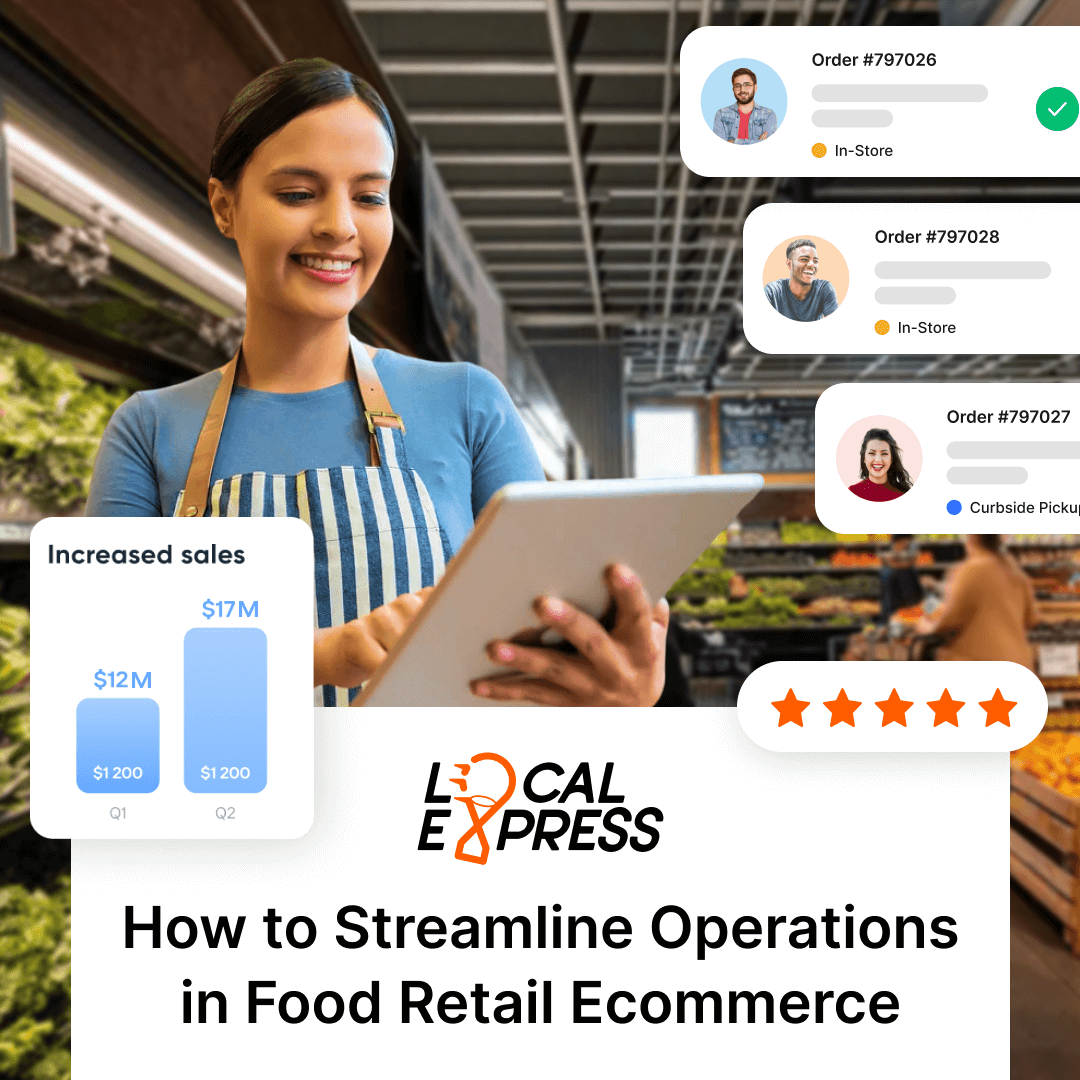


Food retailers lose 5.9% of sales through poor inventory availability while manual picking operations cost $4-10 per order depending on the model—expenses that destroy already-thin grocery margins. Modern unified commerce platforms equipped with AI-powered inventory management and automated fulfillment systems can materially reduce operational costs while maintaining the food safety standards and customer service quality that distinguish successful food retailers from struggling competitors.
Streamlining food retail operations means systematically eliminating inefficiencies across inventory management, order fulfillment, and delivery logistics through technology integration and process optimization. Unlike general retail, food operations face unique complexities: perishable inventory with varying shelf lives, strict temperature control requirements, and the need for First-In-First-Out rotation to minimize the significant food waste before reaching customers.
The financial imperative is clear. With 5.9% of sales lost to out-of-stock scenarios and a significant share of online orders including fresh products requiring specialized handling, operational inefficiencies directly impact profitability. Manual processes that worked for traditional grocery models collapse under ecommerce demands where customers expect real-time inventory accuracy, rapid fulfillment, and consistent quality across channels.
Food retailers typically struggle with disconnected systems creating data silos, manual inventory counts leading to stock discrepancies, inefficient picking routes wasting labor hours, and inadequate cold chain management risking product quality. These bottlenecks compound when managing multiple sales channels without unified oversight.
The foundation of streamlined food retail starts with sophisticated inventory management solutions that go beyond basic stock tracking. Modern systems must handle the complexity of weighted items, batch tracking for recalls, expiration date management, and multi-location synchronization while maintaining the speed customers demand.
RFID technology represents a quantum leap in inventory accuracy. Systems achieve accuracy rates of 95-99% while reducing count times from hours to minutes. This technology enables automatic freshness tracking, preventing the massive waste problem where retailers face significant losses from spoiled products according to USDA food waste research.
Essential capabilities include:
Your inventory platform must seamlessly connect with existing POS systems, ecommerce platforms, supplier catalogs, and fulfillment operations. Without proper integration, you'll face the data discrepancies that plague many grocery retailers who lack sufficient capabilities to use data insights effectively.
Creating an effective software infrastructure requires careful selection of cloud-based systems that scale with growth. The AI-powered data fusion approach eliminates manual data entry by automatically harmonizing information from multiple sources—POS systems, supplier catalogs, and marketplace requirements—into a single source of truth.
Modern inventory management software must handle:
The essential stack includes a central inventory management system, POS integration layer, ecommerce synchronization module, supplier connectivity platform, and analytics dashboard for performance monitoring. Each component must communicate in real-time to maintain accuracy.
Start with POS integration as your foundation, ensuring bi-directional data flow. Add ecommerce synchronization next, followed by supplier connections and finally analytics layers. This phased approach minimizes disruption while building comprehensive capabilities.
Retailers implementing comprehensive inventory solutions report transformative results. Accurate inventory records can measurably increase sales while dramatically reducing waste. These improvements come from better stock availability, reduced markdowns on expiring products, and improved customer satisfaction from consistent in-stock positions.
Independent grocers using modern inventory systems report significant improvements in stock availability, reductions in inventory holding costs, and less time spent on manual counts. One boutique grocery chain eliminated manual inventory entirely by implementing RFID throughout their three locations, freeing staff for customer service while improving accuracy.
Major chains leverage predictive analytics to optimize inventory across hundreds of locations. By analyzing purchase patterns, weather data, and local events, these systems maintain optimal stock levels while minimizing waste—critical when managing thin grocery margins.
Order management systems that significantly accelerate fulfillment through AI-powered store mapping represent the next frontier in operational efficiency. These platforms optimize picking routes, enable multi-order processing, and automate substitution decisions—transforming labor-intensive manual processes into streamlined workflows.
The impact is immediate and measurable. Simple optimizations like bag-as-you-go approaches significantly reduce handling time. When combined with zone-based organization and batch picking, operations can materially improve throughput without adding staff.
Key implementation steps:
Track metrics including picks per hour, order accuracy rates, substitution acceptance, fulfillment time per order, and labor cost per order. Successful implementations show material reductions in pick times, 95%+ order accuracy, and lower labor costs per order.
Omnichannel ecommerce solutions that synchronize in-store and online inventory from a centralized dashboard eliminate the complexity of managing multiple systems. These platforms unify website, mobile app, and kiosk operations while maintaining brand consistency and operational efficiency.
The power lies in centralization. Instead of managing separate systems for online orders, in-store purchases, BOPIS (Buy Online, Pickup In Store), and delivery, unified platforms provide single-point control. This approach prevents the inventory discrepancies that lead to substitution issues causing customer dissatisfaction.
Critical considerations include:
Success requires clear channel strategies, defined inventory allocation rules, consistent brand experience, integrated customer service, and unified reporting metrics. Leading retailers use mobile applications that seamlessly connect with in-store systems, enabling features like scan-and-go shopping that enhance both efficiency and customer experience.
The digital transformation of food retail creates expanding career opportunities in inventory management, with positions offering competitive salaries and growth potential. As automation increases across the industry, professionals who understand both technology and food retail operations become invaluable.
Modern inventory management roles demand:
Career progression typically moves from inventory analyst positions through supply chain management to operations leadership roles. The growing food technology market ensures continued demand for skilled professionals who can bridge technology and traditional retail operations.
Delivery management platforms that reduce delivery costs while integrating with 100+ delivery networks solve the final-mile challenge that breaks many food retail ecommerce operations. These systems coordinate in-house fleets, third-party couriers, and hybrid models from a single platform while maintaining the white-labeled experience customers expect.
The economics are compelling. With last-mile delivery adding $10-20+ per order depending on model to operational costs, optimization becomes essential for profitability. Modern platforms achieve savings through:
Evaluate providers based on coverage areas, integration capabilities, pricing structures, service level agreements, and brand representation. The ability to instantly connect with DoorDash, Uber, and regional providers through single integration streamlines operations while maintaining flexibility.
For retailers operating proprietary delivery, driver apps providing turn-by-turn navigation, proof of delivery capture, and real-time communication become essential. These tools ensure consistent service while providing the data needed for continuous optimization.
Self-service kiosks that reduce labor requirements while improving customer satisfaction represent a critical component of streamlined operations. These systems handle ordering, payment processing, and upselling automatically—freeing staff for value-added activities while serving customers who increasingly prefer self-service options.
The business case is straightforward: kiosks handle unlimited concurrent customers without breaks, sick days, or training requirements. They consistently upsell complementary items, never forget to mention promotions, and collect valuable customer data with every transaction.
Successful deployment requires:
Metrics demonstrate rapid payback through increased average transaction values via automated upselling, reduced labor costs from decreased cashier requirements, improved order accuracy eliminating miscommunication, faster service times during peak periods, and enhanced data collection for marketing optimization. Many retailers report they can achieve positive ROI within a year under the right conditions.
Effective data management using AI-powered harmonization transforms raw product information into clean, enriched content that powers all digital channels. This capability becomes critical when managing thousands of SKUs across multiple platforms, each with different data requirements and formats.
One-click marketplace integration exemplifies the power of proper data management. Upload your catalog once, and AI streamlines listing and reduces setup time to Instacart, DoorDash, and other platforms—handling complex variations like weighted items that traditionally require manual configuration, though actual launch depends on marketplace approvals and data completeness.
Essential elements include:
Continuous data quality requires automated validation rules, regular audits and corrections, supplier data standardization, exception handling workflows, and performance monitoring dashboards. Poor data quality leads to customer dissatisfaction, operational inefficiencies, and compliance risks that can devastate food retail operations.
LocalExpress goes beyond typical ecommerce platforms by providing the comprehensive unified commerce solution that food retailers need to compete effectively. Unlike pieced-together solutions that create integration nightmares, LocalExpress delivers everything from inventory management to last-mile delivery in one cohesive platform.
What sets LocalExpress apart is the AI-native approach to every operational challenge. The platform's AI Grocery Data Fusion module automatically harmonizes data from POS systems, supplier catalogs, and marketplaces—eliminating the manual work that consumes hours daily. Combined with predictive inventory management that maintains optimal stock levels and order fulfillment systems that significantly accelerate picking, LocalExpress transforms operations from cost centers into competitive advantages.
The platform particularly excels at helping independent retailers compete with major chains. Through one-click marketplace integration, smaller retailers can streamline their listing on Instacart and DoorDash without technical expertise. The retail media platform even creates new revenue streams by enabling CPG brand partnerships—turning your digital presence into a profit center.
For specialized food retailers, LocalExpress offers tailored solutions like prepared food management with kitchen display integration, bakery-specific features for custom cake orders, and butcher shop capabilities handling variable-weight items. This specialization, combined with white-label branding that maintains your unique identity, makes LocalExpress the optimal choice for food retailers serious about operational excellence.
Streamlining food retail operations means systematically eliminating inefficiencies across inventory, fulfillment, and delivery through technology integration and process optimization. This includes implementing unified platforms that synchronize data across channels, automating manual tasks like inventory counting and order picking, and optimizing workflows to reduce labor costs while improving accuracy. The goal is creating seamless operations that handle increased volume without proportionally increasing costs or complexity.
Implementation timelines range from a few weeks to several months depending on complexity and the size of your store. The process includes initial setup and data migration (3-5 days), POS system integration (2-3 days), staff training on new procedures (2-3 days), testing and optimization (3-5 days), and full deployment with monitoring (1 week). Most vendors provide dedicated support during implementation to ensure smooth transition without disrupting daily operations.
Yes, modern inventory management platforms integrate with major POS systems including NCR, Toshiba, IT Retail, and dozens of others through API connections or direct database synchronization. This integration enables real-time data flow, ensuring price and inventory consistency across all channels. When evaluating systems, verify specific compatibility with your current POS and understand whether integration is native or requires third-party connectors.
Streamlined operations typically deliver 20-30% reduction in labor costs through automation, measurable revenue increases from better inventory availability, reduced last-mile delivery expenses, and decreased food waste through improved rotation. Combined improvements can achieve positive ROI. For example, batch picking can materially reduce picking time, directly translating to labor savings.
Self-service kiosks streamline operations by handling unlimited simultaneous customers without additional staff, maintaining consistent upselling and promotion communication, eliminating order errors from miscommunication, reducing queue times during peak periods, and collecting customer data for personalization. Kiosks free existing staff to focus on food preparation and customer service rather than order taking, improving both efficiency and satisfaction.

